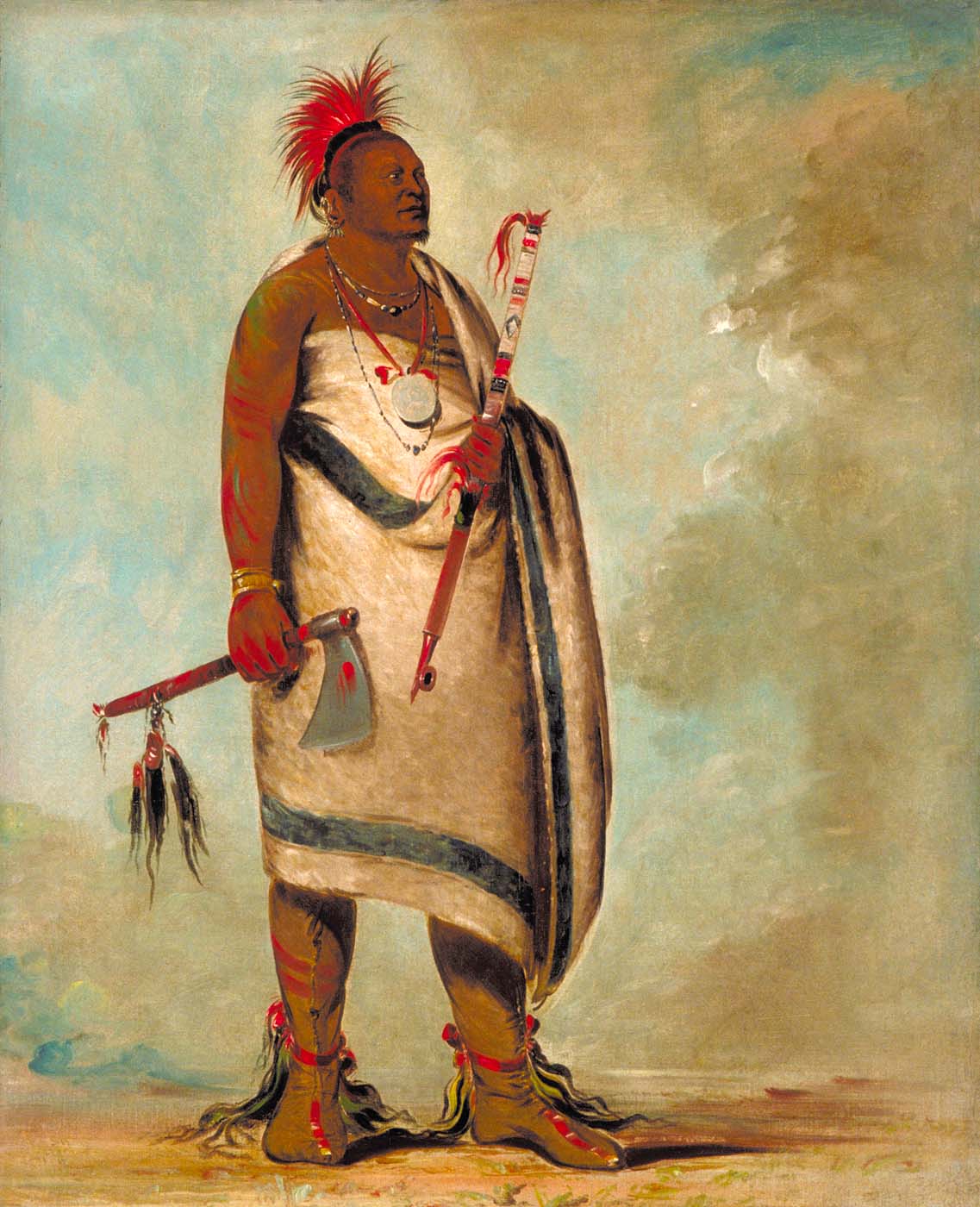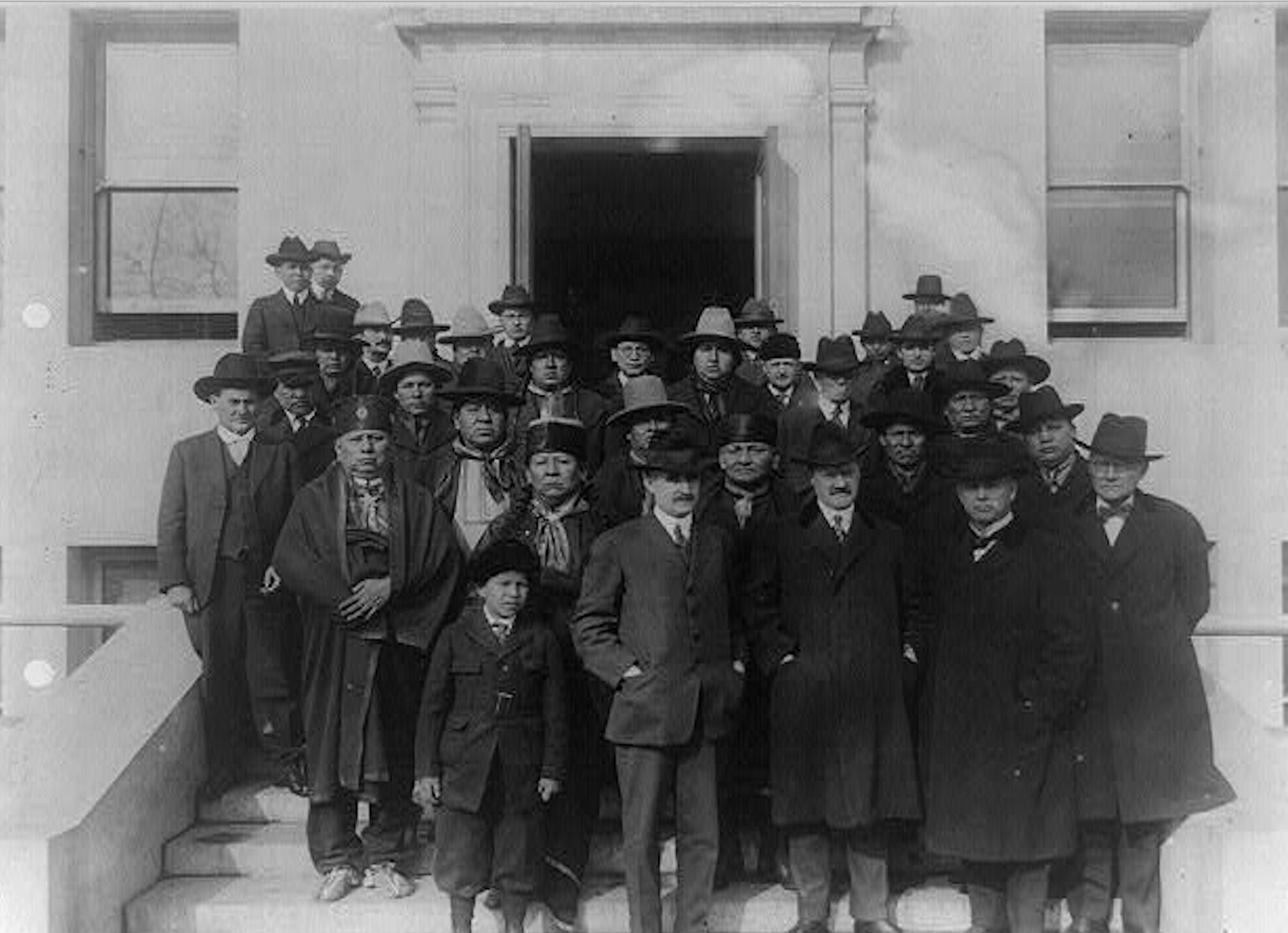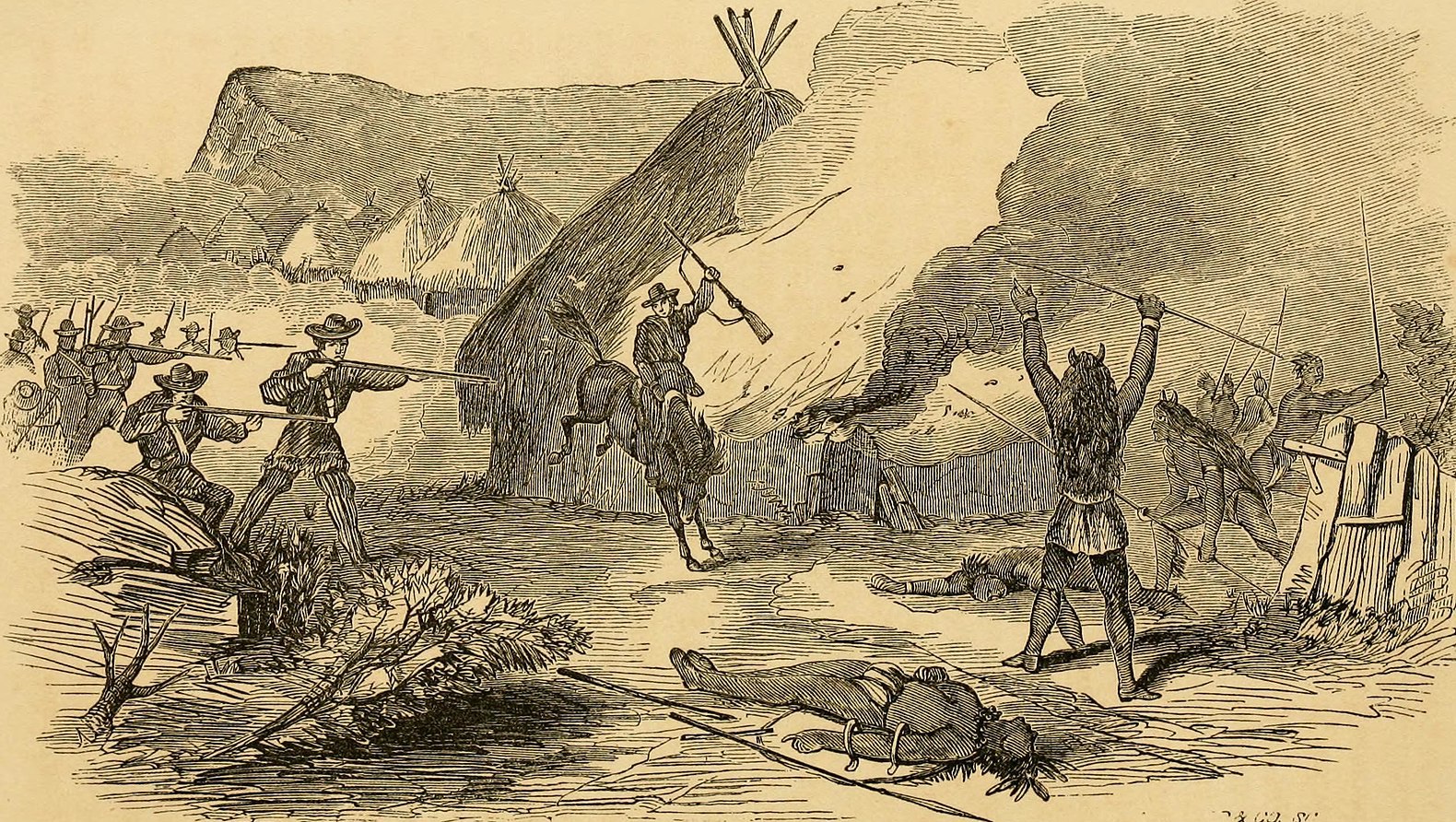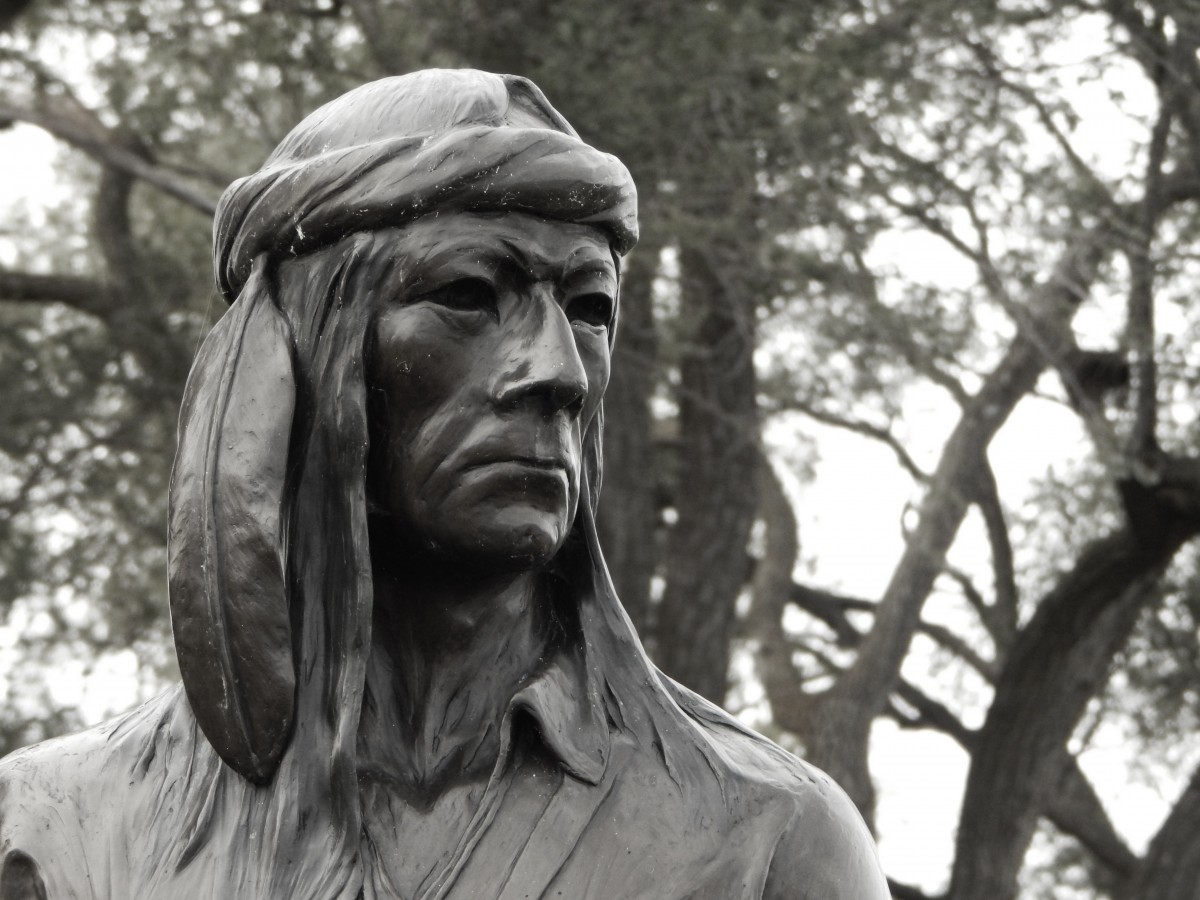The following is the second of a two-part series. The first can be found here.
Indian cultures are very complex, and Osage culture is no different in that regard. Every ukon or wigie[1] is aligned around these paired divisions, and particular clans might have clan specific-responsibilities (hence, division-specific) in any wigie or ukon. For example, two of the hunka clans each have a responsibility to “keep” specific pipes that were dedicated to military actions of defense or the buffalo hunts, and no deliberation to prepare for defense could continue without one of these clans stepping forward with one of these designated pipes.
At the same time, for this occasion of supporting the “defenders,”[2] it was another clan from the other division that was called upon to bring the tobacco for loading this pipe. Again, in this small moment in a larger twelve-day event, one can see the importance of having both sides of the road deeply involved in a complimentary dualistic form. The pipe from the hunka and the tobacco from the tsisho begins the process, in this case, of bringing the whole people into unity of action, just as the two primordial energies of sky and earth insure harmony and balance in the cosmic whole.
Hence my pointed query: is tying my shoes part of a religion? When my daughter learned to tie her left shoe first and then her right, is this a religious act—by definition in the academy? If it is to be conceived as religious, then what actions of people in this old traditional community are to be classed as non-religious (or even more curiously, as secular)?[3] And if it is deemed not a religious act, why so? Where is the dividing line between religion and not-religion?
Do not all acts suddenly become religious? If all of life and every personal as well as community act is religious, then what can religion possibly be in this context? This is akin to the word “sacred” when it is used to casually translate wakon. It turns out, in every Indian language, that everyone (both humans and all the others) and every place is sacred. So then, what can sacred mean? If it means everything, then why not use the word everything? In other words, both sacred and religion become meaningless ciphers when they are applied to Indian people.[4]
How, then, will religion scholars separate out in Indian cultures what might primarily interest them as religious aspects of these societies—when there is nothing or nearly nothing left over, and how will scholars of religion rationalize what they have done? Here, you see, categorization fails. Our world is a very different world. Deal with it.
Otherwise we are forced to conclude that scholars in religious studies are merely game-playing at some sort of narrow anthropology, where random aspects of a community’s life come under the academic microscope for its “religion” implications. Here, I am “playing” with J.Z. Smith and Sam Gill—perhaps as a ludic simulacrum of Gill’s discourse, particularly his theoretical argument in “No Place to Stand: Jonathan Z. Smith as Homo Ludens: The Academic Study of Religion Sub Specie Ludi.” In this essay, the author casts the corpus of his own teacher’s interpretive work as a structured form of play.[5] Is he warning us not to take our academic discourse too seriously?[6]
Gill, himself, has a long history of playing with American Indian Peoples, going back to the fatuous absurdity of his “Mother Earth” book, irrefutably a classic colonialist ludicrosity (to build again on his notion of “sub specie ludi”[7]). I do not mean to merely gainsay Gill’s theoretical use of Johan Huizinga’s important 1938 book, Homo Ludens, but Mother Earth was as damaging to Indian Peoples as it was laughably inane. Structured as a piece of academic research conforming to religious studies style, Mother Earth is heavily annotated with a great deal of evidence—all of it carefully cherry picked to prove his thesis and none of it verified on the ground with actual Native communities and none of it traced back to actual Native language usages.
But then, for most academic specialists in American Indian stuff, mastering a Native language is not at all important. For other narrow categories of religious studies language proficiency is always required: i.e., biblical studies require greek and or hebrew (and even latin, all preferably capitalized); chinese religions require mastery of mandarin or some chinese dialect; hinduism requires mastery of sanskrit, etc. For this discipline called American Indian religions, however, anyone can play—and get tenure.
In Mother Earth, Gill attempts to demonstrate that the presumed ubiquitous presence of a mother earth goddess figure was a brand-new notion for 19th century Native Peoples in north America, adopted directly from their colonizers’ narrative ideation of mother nature/mother earth. Indeed, by Gill’s account, Indians were so impoverished in our understandings of our own world that we were forced to build the foundations of our worldview by reading the New York press and adopting ancient european mythology and language (i.e., mother earth) as our own in the early 1800s![8] I’m sure that Tecumseh (d. 1813) and his brother Tenskwatawa, among thousands of other Natives across the continent, must have had subscriptions to the National Gazette or New York’s first daily American Minerva,[9] but Gill doesn’t clarify how the papers made their daily delivery in the (hostile?) Shawnee communities of the tensive Ohio Valley in those days, let alone across the still Indian western half of the continent.
In essence, Gill’s argument is a straw-man argument, one that is not at all rooted in any actual American Indian culture or accurate historical analysis but depends on White, euro-christian cognitional categories that he and others have regularly imposed on Indian people, having presumed that their own euro-christian language is coded for universality. Two points here should suffice to highlight the problematic.
First, Gill’s evidentiary citations in that regard are entirely from colonialist translations of what euro-christian observers thought that Indian folk might be saying.[10] That’s good enough for homo ludens Gill. Being Native language deficient, Gill can only trace a history of written documentary evidence reporting the english words that euro-christian observers used to signify whatever it was that these observers imagined Natives said in their own complex languages. Indeed, there is always only a tenuous and imaginative connection at best between any english utterance and its supposed Native equivalent (in any Native language).
To wit, Gill satisfied himself with using standard euro-christian sources about Indian Peoples and their cultures. At no point did he bother to ask Indian folk or to investigate actual Indian communities. Underlying this sort of evidentiary analysis is the deep academic notion that all historical evidences for Indian cultures must be in written form catalogued by euro-christian observers.
My second point, however, is more pertinent to this discussion. Namely, to set up the strawman (woman) of an earth mother goddess naively presumes the universality of the words god and goddess as a normative part of every human group’s languaging of the world. As I have argued elsewhere, Indian languages simply lack any words or equivalencies for the euro-christian category “god” until euro-christians pick one in each language,[11] which does not stop Gill from presuming the fact. Of course, Indians did not historically and still do not “believe” in Gill’s mother earth “goddess.” He did not even need to write his book to make that point!
While all Natives on the continent had (and have) deeply embedded notions of what Barbara Mann calls the twinned cosmos, there was and is no way to describe that twinning in terms of deity or deities, gods or goddesses. Yet the notion of “grandmother” as the earth half of that twinned cosmos is pervasive. One measure of its antiquity is that it is ever-present both in the oldest stories the people tell and in the ancient ceremonial songs they continue to sing today. Gill simply fails to ask, presupposing the usual arrogant colonizer impudence, learned from J.Z. Smith in the classroom, that the trained euro-christian observer already knows better than we Natives. Gill, who is Native language deficient, can only be tracing a history of the english words that euro-christian observers used to report publicly whatever it was that Natives said in their own complex languages. Indeed, there is always only a tenuous connection at best between any english utterance and its supposed Native equivalent (in any Native language).
In much the same way, the colonialist academic inventive creation of Indian religions always harms Indian Peoples. I am sure, by the way, that the vast majority of euro-christian academics who teach and write about “Indian religions” think of themselves as doing actual work rather than merely engaging Gill/Smith’s “sub specie ludi” (i.e., a type of game-playing).[12] Nevertheless, these outsider colonialist descriptions of Indian communities most certainly shape non-Native perceptions of the Native world and then eventually also strongly tend to reshape those same Native communities in perverse transformative ways.[13] Native American “religions” only come into focus as the colonizers re-inscribe themselves into the Native community, re-inscribing their words into the Native language and shaping the Native People as some primal replica of themselves, as a mini-me. And eventually, many Native folk begin to buy into this colonially redesigned self as genuinely their own authentic selves.
Thus today, American Indians have come to have religion. And indeed, Native religion looks more and more like the colonialist himself. These modern postcolonial Indian religions are shaped after christian religious structures with some add-on symbolic Native forms and ideas, or they tend to conform with new-age individualism. These, however, are not “American Indian” religions. At least not in any uncomplicated form and particularly not in any Indian traditional sense.
In terms of American Indian traditional cultures, then, there is no Native American religion. Essentially, we are left with J.Z. Smith’s famous 1982 dictum about religion generally:
…while there is a staggering amount of data, of phenomena, of human experiences and expressions that might be characterized in one culture or another, by one criterion or another, as religious–there is no data for religion. Religion is solely the creation of the scholar’s study. It is created for the scholar’s analytic purposes by his imaginative acts of comparison and generalization. Religion has no independent existence apart from the academy.[14]
Certainly here, Gill is correct; we are dealing with sub specie ludi, indeed. That, however, effectively and merely re-inscribes victimhood on Indian people who find themselves again fighting to negate false knowledge about themselves. But then, the whole structure of academic discourses is set against Indian difference. By the academic doctrine of analogy, everything in the world must be like something the scholar already knows. Under the deadly weight of colonialism and its continuing legacy, this is becoming true across almost all human cultures today, and the academic study of religion is a significant player in that process.
Carl Raschke strongly implied this in the title he gave for my oral presentation of these ideas at our symposium back in November: “Is Religious Studies Just the Latest Form of Euro-christian Colonization of Indigenous Peoples?” That this is the case is the substance of my argument. Yet, on the other hand, the enterprise serves the positive purpose of giving jobs to a plethora of otherwise unemployable White euro-christian academics.
Tink Tinker, wazhazhe udsethe, is the Clifford Baldridge Emeritus Professor of American Indian Cultures and Religious Traditions and a citizen of the wazhazhe udsethe (Osage Nation). His career spanned 34 years at Iliff School of Theology where he also taught in the Iliff/DU Joint Doctoral Program. During his tenure at Iliff, Tinker also provided (pro bono) leadership for the Four Winds American Indian Council, a local urban Indian community project.
______________________________________________________________________________
[1] These words reference certain community acts that euro-christian academics might label “ceremonies” or “rites”, but those colonialist categories really do not do justice to the acts themselves. They belong in an osage community context and should not be forced into some convenient cognitional category to satisfy the euro-christian desire to know and control. So, I prefer to leave the words untranslated.
[2] That is, the akida, almost always mistranslated at “warriors.”
[3] To wit here, I am obliquely referencing notions from Durkheim’s “sacred and profane” and to Mircea Eliade’s reiteration of Durkheim and his presumption of hierophanies as foundational for any religion. Particularly central is the ubiquitous notion of supernatural. None of these cognitional categories pertain to traditional Native American lived experiences. They must be read back into the traditions, and especially back into the texts generated by the so-called experts.
[4] It should be noted that calling certain sites “sacred” completely obfuscates the Native reality of a particular place having a close association with some wanagi who either lives at that place or uses that place to communicate with humans. Even Indian politicians regularly fall into the “sacred site” motif when talking to non-Natives.
[5] Published in the Journal of the American Academy of Religion, 66/2 (1998): 283-312.
[6] Gill is, of course, making theoretical use of Johann Huizinga’s 1938 book by the title Homo Ludens: A Study of the Play-Element in Culture (english translation: Routledge & Kegan Paul Ltd, 1949).
[7] Much like an armchair quarterback, Gill builds his case with plentiful annotative evidence, all cherry-picked to prove his colonialist fantasy. Unfortunately, he never bothered to ask Native folk—much like Levi-Straus and too many other religious studies academics.
[8] Sam Gill, Mother Earth: An American Story (Chicago, 1987). Ward Churchill, “Sam Gill’s Mother Earth: Colonialism, Genocide and the Expropriation of Indigenous Spiritual Tradition in Contemporary Academia,” American Indian Culture and Research Journal, Vol. 12:3 (1988), pp. 49-67.
[9] These are two of the earliest daily newspapers in the original colonies of the new republic, predecessors to the New York Times, et al.
[10] The problems with “chief Seattle’s” so-called speech are legendary, to say the least. All we can conclude is that Sealth (not Seattle) gave a speech and that it may have contained some of the rudimentary ideas that got twisted around in the long-after-the-moment victorian english memory of one of the euro-christians present.
[11] “Why I Don’t Believe in a Creator,” in Buffalo Shout, Salmon Cry: Conversations on Creation, Land Justice, and Life Together, edited by Steve Heinrichs. Herald Press, 2013. Pp. 167-179. The underlying notion is always predicated on some notion of a human universal rooted in language of the supernatural, sacred and profane, Otto’s “Idea of the holy,” the spiritual, “belief” and “faith”. When Indian folk today use words like god or creator when speaking in english, we need to understand the original concept in Native languaging was much more complex and distinctly Other than these english words can even begin to express. At this late date in the processes of colonialism, the english words simply become common ciphers for what our ancestors knew.
[12] One might conclude that Tink Tinker is just an “academic like us. He seems to be speaking academically just as sub specie ludi as the rest of us.” Fair enough, at one level. A key difference is that I live what I speak and write 24 hours a day. I never get to step away from who I am or forget where (locality/spatiality) I am. At the same time, it is easy to point to Tinker’s title and say, but wow, he actually taught “religious traditions.” Yes, that was the title imposed on my historically back nearly 30 years ago, and that is a much longer story that is interesting in its own right. Suffice it to say, the title satisfied the political structures of my institution and its faculty, but the truth is that I pretty steadfastly avoided teaching what my title said I was. I much rather taught Indian cultures and worldview, and used the latter, a singular noun in this case, to differentiate the Native worldview from the eurochristian colonial worldview.
[13] This is somewhat akin (at least metaphorically akin) to the observer effect in physics.
[14] Jonathan Z. Smith, Imagining Religion: From Babylon to Jonestown (University of Chicago Press, 1982), xi.




